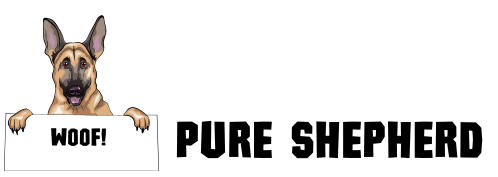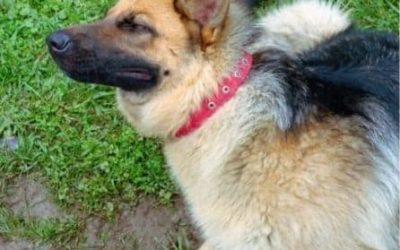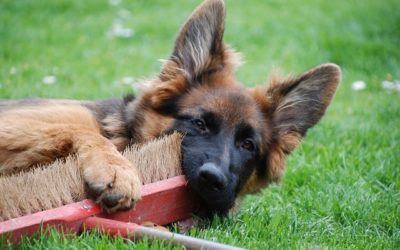What is A Double-Coated Dog?
One popular characteristic of German Shepherds is their double coat. You may have heard about it but telling a double-coated dog from the rest might be your strongest fit yet.
Also, you could be having some doubts about
- How to groom your double-coated German Shepherd
- Whether or not you should shave your pooch
- How often to bathe it
And so on.
This short guide will be addressing all these concerns to give you an easy time as you goof around with your dog. Let’s get to it!
What is a double coat on dogs?
A double coat is simple really – it is what it says – a coat of fur that has two layers.
The innermost layer is dense with numerous short hairs that have a general wooly texture to them. In contrast, the second outermost layer has slightly longer hairs known as guard hairs. These are vital in repelling dirt and moisture from the dog.
We’ll look at the function of the double coat in a while.
Besides the German Shepherd, other dogs with double coats include huskies (Siberian and Alaskan), Chow Chow, the Golden retriever, and the Akita just to mention a few.
Do all dogs have double coats?
This might seem like a no-brainer to most people but to some, it might not be so clear. After all, every moment spent with your shepherd – or any other dogs for that matter is a learning opportunity.
The answer is that no, not all dogs have a double coat.
Some have what we call a single coat which means they lack an undercoat found in their double-coated counterparts. And by extension, they also lack the short soft hairs spotting only the longer guard hairs that serve pretty much the same purpose as in German shepherds.
In the single coat category, you’ll find the likes of Greyhounds, Poodles and Dalmatians among others.
That aside – how can you tell apart your double coated German shepherd from a single coat hound?

Double Coated dogs include German Shephers, Huskies – Siberian and Alaskan, Chow Chows, the family favorite Golden retriever, and the Akita

Some single coated dogs include Dalmations, Greyhounds and Poodles
Double Coat vs Single Coat Dogs
Now you’re familiar with what a double and single coat means, but what aspects can you use to differentiate these two?
Shedding is a sure way that sets apart the two dog coats. If you’ve had your German shepherd for a while, you should have seen the kind of hairs it leaves behind. And you’ll have spent plenty of time with your hoover!
Usually, the hairs you see don’t come off singly or separately. Instead, they’re in small finely textured mounds. That is the undercoat coming off to give way for the growth of new hairs. German Shepherds – and all double coat dogs in general – shed the undercoat often as it tends to grow faster than the guard hairs.
And yes, this means more grooming work to you.
Now to the single coats – their shedding is a complete opposite of the double coats. That means instead of finding clumps of hair, you’ll pick up hairs that are a bit spread out. And since there is no rapidly growing undercoat, this shedding is not so frequent as compared to your German shepherd.
So does this double coat serve any particular function other than giving you a hell of a grooming task? Turns out, yes.
The Significance of a double coat in hot and cold weather
The double coat serves one important function in German shepherds – insulation. Well, maybe not the whole double coat but on the whole that’s what it’s useful for.
For a larger part, insulation is influenced by the dense lower layer of fluffy soft hair. This cover effectively protects your pooch from unnecessarily losing heat in conditions where it’ll be fatal to do so – like Winter, for instance.
But just as it prevents loss of body heat, their thick coats also protect against heat gain in hot conditions, especially during the Summer.
In breeds that were bred specifically for hunting, the double coat was perfect protection against a would-be attack from whatever the animal the dog was chasing after.
That’s it about the importance of double coats. Obviously, they’re quite useful to the German Shepherd. But as mentioned earlier, you’re going to have quite a handful of grooming to do.
in the module Design settings and even apply custom CSS to this text in the module Advanced settings.
Double coated dog grooming
A double-coated dog like a German Shepherd is going to shed hair – a lot. This is only natural considering the rapid growth of the undercoat.
With that, you cannot afford to fall behind in grooming that furry friend of yours. That’s if you don’t want to end up with a house full of dog hair – and a few more complications for your dog.
For one, lack of grooming could lead to your dog having a matted undercoat that can cause a range of skin infections. So if you don’t mind swimming in dog hair at least groom your German Shepherd for his own good. It’s also a great opportunity to bond with your dog and allows you time to check your dog over for its general good health, inspect their ears, trim their nails etc.

How Many Times Should You Brush Your Double Coat German Shepherd?
Speaking of grooming, a good brushing session should suffice, but remember, because of that undercoat you’ll have to do it a few more times per week. Just how many these times will be is dictated by whether your German Shepherd is in the heavy shedding period or not.
Heavy shedding occurs twice per year during spring and fall. And this when you should ensure you’re brushing your doggo every day to keep him as clean as possible.
For the rest of the year, a couple of times per week is still great but it’s better if you can do it every day.
Dog Undercoat Removal
You’ll have to completely remove your German shepherd’s undercoat every spring and fall as you’ve already seen above. These are the times when your canine friend gets into a new coat altogether.
Removing the old undercoat ensures your dog is clean and ready to go for the new season. For this, you’ll need an undercoat rake that is well-suited for pulling away those loose clumps of hair. Take note – an ordinary dog brush will not be as thorough in doing this.
Speaking of undercoat rakes, this PatYourPet tool can be just the tool for you! It’s a great multi-purpose tool which you can use for the regular brushing, de-matting, and de-shedding. This one tool should mean that you won’t need a heap of other tools to keep your GSD free from rogue hairs.
Alternatively, you can also use a basic slicker brush, a pin brush and the furminator.
Every German Shepherd owner agrees to this basic way of removing the undercoat. But there is one thing that gets dog owners really riled up.
Double Coated Dog Shaving
Shaving or trimming a double coat dog is a hot topic! While the majority agree that shaving is a no-no, there are still a few people out there who insist on shaving their double coat German Shepherds.
So which direction should you take?
We think clipping or trimming your German Shepherd is probably the worst treatment you could put it through. And it’s not just a matter of opinion – there are many perfectly valid reasons behind this.
The Problem With Shaving A Double-Coated Dog
First off, a shaved Shepherd is just not visually appealing. By shaving, you’re taking off the glossy guard hairs that make your dog look so attractive and provide those so recognizable markings – especially in black and tan Shepherds. What remains is the fuzzy undercoat which let’s face it doesn’t look good and could even be scratchy for your dog.
Secondly, your dog’s hair might never grow back in quite the same after shaving. This is mainly due to the topcoat being affected by the clip because unlike the undercoat, it doesn’t grow as fast. And even if it grows back, it might never reach the same length. It could also fail to grow back in some places leading to your German shepherd having patches. Not a cool look for a cool dog.
Lastly, a shaved dog is exposed to nature and its weather conditions, only natural considering you’ve robbed your dog of its natural protection and cover. It’ll be susceptible to sunburn and won’t fare well in both cold and hot temperatures. So you end up with a stressed up dog with potential for health problems. Not what you want.
So, that’s it about shaving your dog. There is another aspect of taking care of your German Shepherd that you should consider – bathing.
How Often Should I Bathe My Dog?
Unlike brushing, shaving your German Shepherd shouldn’t be bathing so frequently. Naturally, the dog has lots of oil in its coat which works fine in maintaining a glossy look. The American Kennel Club recommends bathing your dog once every 4-5 months.
Frequent baths tend to wring the coat of its natural oils leaving it dry.
When you do bathe your German shepherd, a shampoo can go a long way in adding to the glow. For instance, Nature’s Specialties Tar & Sulfur With Aloe Shampoo penetrates your dog’s coat in minutes to give an instant glow.
Final Thoughts on Double Coat Dogs
We hope you learnt a little more about double coats, it makes it so much easier about what to do – and not what to do – when it comes to grooming.
In summary you know frequent grooming is a must for double coats, and shaving is an absolute no if you really love your dog.
Now that’s not so complicated, is it?







